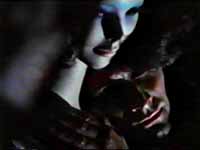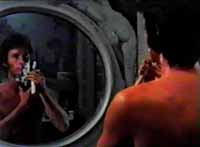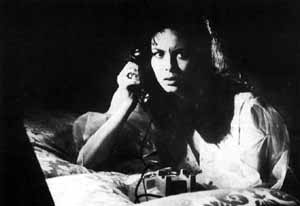|

A man and his mannequin, from
Hatchet for the Honeymoon.
The overt "key" to his psychopathology is the elaborate ritual by which he lures fashion models to their deaths. Unlike the serial murders of models in Bava’s earlier Blood and Black Lace (Sei Donne per l’Assassino, 1964), the designer/killer in Hatchet for the Honeymoon is revealed in the introductory scenes. His "motifs," the childish music box theme which he plays while seducing his victims or his Oedipal dreams of his own mother’s murder on her wedding night, initially suggest a "classic" disturbance of emotional trauma and repressed sexuality redirected into uncontrollable outbursts of violence. However, Bava altered the expressive meaning of these clichéd motifs by disclosing from the first the extent to which the central figure is aware of the symbolic nature of his behavior. As he remarks in voice-over after the title sequence killings, while he examines his face in a train compartment mirror, "No one would think to look at me that I am completely insane." This awareness at least partially deconstructs the traditional symbols and the false, social assumptions that underlie them.
The perversely Freudian touches--such as the burnt bread popping out of the toaster when the protagonist argues with is wife over his sexual disinterest in her--set a tone that is satirical at first. But as the killer is overpowered by his own aberration, they also suggest the breakdown of his control. He violates the criminal pattern he has set for himself, the pattern in which he feels insanely secure, by attacking his wife. The immediate result is that he is almost caught in the act. The long-term effect is that he is now plagued by his wife’s vindictive ghost. As in earlier pictures, Bava did not choose to clarify whether this haunting is genuine or imaginary. The schizophrenia of the protagonist is established in the opening scenes, in which the character as a young boy lurks outside a train compartment while his adult self enacts the English-language title sequence and attacks some newlyweds with an ax. As the movie progresses, his disturbance overwhelms both his rational self and the film’s imagery.

"No one would think to look at me that
I am completely insane."
From Hatchet for the Honeymoon.
A single cut from the murderer’s subjective viewpoint to an objective angle in Hatchet for the Honeymoon may express the same dichotomy between reality and illusion as an entire, elaborate set piece, such as the visit to the oracle in Hercules in the Haunted World. On some occasions, Bava might insert a ritualistic archetype merely to serve the mechanics of plot: for example, the black helmet worn by Rurik in Knives of the Avenger (Raffica di Coltelli, 1967), which conceals his face when he rapes his enemy’s bride. But most often these devices have an expressive as well as narrative value. The masks of the oracle Medea or the sorceress Asa may, like that of Rurik, conceal their identities. But masks are also larger-than-life, and the characters who wear them take on a protean aspect that is both figurative and melodramatic outside the context of the story line.
The extent to which Bava’s mise-en-scene is calculated to use genre expectations and elicit particular viewer responses is most easily analyzed in his mysteries and costume films. In the former, we don't see detective heroes methodically stripping away the layers of deception created by the criminals; instead, either the criminals themselves or the potential victims are the main characters. Neither the methods of the police nor the intricacies of the plot are as significant as the underworld of deviant behavior, like the ambiance of film noir, which criminals and victims cohabit. The long pursuit through the rural streets and alleyways in Baron Blood and the opening murder in the night mist of a city park in Blood and Black Lace are typical. Figures are forced to flee from obscure assailants, past isolated street lamps or lighted windows that offer no safety and across dim nightmarish landscapes that would, in daylight, seem perfectly ordinary and unfrightening. Even inside a locked apartment, as in the second episode of Black Sabbath ("The Telephone"), a woman may be so unnerved by a voice coming through a receiver that the sound of telephone ringing is suddenly louder and more menacing that a gun shot.

From "The Telephone" episode of Black Sabbath.
Such visual and aural statements can have a multiplicity of keys. First, they are direct stagings of suspense sequences, using lighting, opticals, and cuts to enhance viewer apprehension. Second, they externalize the disturbed interior states of the characters. Finally, they are non-specific metaphors for either a noir-style underworld, as in The Evil Eye or Blood and Black Lace , or in the supernatural films, a chaotic, almost formless universe somewhere beyond the boundaries of normal, material reality in which ordinary persons may inadvertently stumble, as in Black Sunday or Kill, Baby, Kill. Even in the costume films, which antedate the "sword and sorcery" genre, Bava worked against a type that relies on a hero of preternatural strength or special martial ability. The title figure of Hercules in the Haunted World is strong but by no means indomitable and requires the assistance of legendary companions to complete his mission in the underworld. The Viking heroes of Erik the Conqueror and Knives of the Avenger are strong warriors but their mythic aspect is understated. Just as the non-criminal figures of the modern films, these heroes may be placed in fateful situations by exterior powers, or as Rurik ruefully observes in Knives of the Avenger, "Odin decides what our destinies are."
Bava’s modern day thrillers conform to a somewhat sexist mythology of their own, which can be more rigid that the pre-established context of the costume pictures. The beautiful young models in Blood and Black Lace, episode two ("The Telephone") of Black Sabbath, Hatchet for the Honeymoon, and Five Dolls for the August Moon (Cinque Bambole per La Luna d’Agosto, 1969) are all ostensibly normal people. Yet their very profession suggests a commitment to surface values and appearances. They are perfect victims for Bava’s patriarchal narratives because they epitomize the complacency and superficiality of the modern world. Confronted with a para-normal threat, be it a ghost or a psychopath, these human mannequins are ill-equipped to save themselves.
page 3 of 4
 
Italian Horror Menu page
Italian Horror: A Brief Introduction
Mario Bava: The Illusion of Reality
Mario Bava's Rabid Dogs
Mario Bava Biography
The Horrible Dr. Hichcock
The Devil's Commandment 
Castle of Blood 
Nightmare Castle
The Bloody Pit of Horror 
Italian Horror in the Seventies
Suspiria
Italian Horror Web Links
Photo credits: Silent Scream and Sinister Cinema.
|





